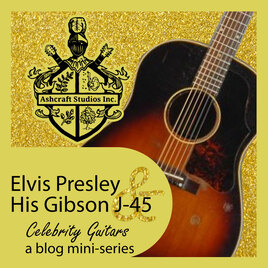 When you think Elvis Presley, you think gyrating hips, flashy clothes and the King of Rock and Roll. From meek beginnings in Tupelo, Mississippi to his massive Graceland estate in Nashville, Tennessee, the hip shaking, guitar toting, musical sensation has entertained countless fans worldwide. And as legendary as Presley himself, the humble Gibson J-45 was born without privilege but quickly became musical royalty. The J-45 was often seen by Presley’s side in multiple performances and has been the go to acoustic for numerous artists throughout music history. The guitar is still one of Gibson’s best-selling guitars to date and can fetch a price tag upwards of $5,000. Dubbed “The Workhorse,” the Gibson J-45 was first introduced in 1942 despite mounting war efforts for World War II. Government imposed rations forced Gibson to rethink how the guitars were made while maintaining a low price tag. With 90% of the company’s work force dedicated to war time projects, Gibson’s few available workers designed a guitar that was stylish but not flashy with a great sound at an affordable price. The group created a guitar that used up to four pieces of the then rare spruce for the guitar’s top and used a sunburst finish to hide any flaws in the wood. The model earned its name from the price tag set at $45. Despite the guitar’s meager beginnings, the J-45 has been praised for its full and balanced sound and has been the acoustic of choice for many big name musicians. John Lennon first learned the fingerstyle/draw-hammer technique from Scottish singer Donovan Leitch on a J-45 which later inspired multiple songs on the famous White Album. Donovan had a cherry sunburst J-45 which was unfortunately stolen from a concert hall in the 1970s. Bob Dylan also used a 45 in his early albums and later returned to using it as his acoustic of choice in the mid-90s. Buddy Holly also used the 45 to record famed songs such as “Everyday,” “Send Me Some Loving,” and “It’s Too Late.” Elvis Aaron Presley was born in Tupelo, Mississippi on January 8, 1935. Born to Vernon and Gladys Presley, he came into the world as a poor man with few resources. As a result of the family’s impoverished position, the family often moved for work landing them in Memphis, Tennessee in 1948. Presley’s mother was deeply religious and Presley found himself inspired by the hymns and gospels sung at the family’s church. He was also inspired by the R&B tunes he often heard along the historic Beale Street in Memphis. When Elvis was 11, his mother gifted him his first guitar for his birthday. A few years later Presley used his talent to win a talent show at his school, Humes High School. His professional career began in 1954 when he recorded his first album under the label soon to be called Sun Records. The following year his contract was sold to RCA and by 1956 he was a worldwide star. His illustrious career included 33 successful films, numerous television appearances, over one billion records sold, gold, platinum, and multi-platinum awards, and 14 Grammy nominations of which 3 were won. He was the first to be inducted into the Rock and Roll Hall of Fame in 1986 and was later inducted into the Country Music Hall of fame in 1998 and the Gospel Music Association’s Gospel Music Hall of Fame three years later. While it’s true that Presley used many guitars throughout his career, the J-45 was prevalent throughout his career. He was often seen playing the iconic guitar in movies like Loving You, King Creole, G.I. Blues, and Blue Hawaii, and although he played a Martin 0-17 and a Harmony H165 in Girls! Girls! Girls! he’s seen playing a Gibson J-45 in the movie’s promotional materials. Fun Fact: The Hawaiian steel guitar seen in Blue Hawaii is actually just a Gibson J-45 with the pickguard covered in aluminum. Both guitar and artist came from humble beginnings, but both Presley and the J-45 have found their place in rock and roll history. Born out of the hardships of wartime resource scarcity, the Gibson J-45 managed to work its way into the hands of an underprivileged young man from Mississippi who later went on to have the world at his fingertips. Now one of the Gibson’s best-selling acoustic guitars, the 45 and Elvis seem to be a perfect match. Not bad for a $45 guitar right? Sources: https://www.sweetwater.com/store/detail/RS45VSN19--gibson-acoustic-j-45-standard-vintage-sunburst http://23.21.158.208/News-Lifestyle/Features/en-us/The-Gibson-J-45-20-Essential-Facts.aspx http://www.scottymoore.net/epm_propJ45.html https://www.biography.com/musician/elvis-presley https://www.graceland.com/biography Thanks for joining us on our Celebrity Guitar tour. We hope you enjoyed the articles and maybe even learned something new. Make sure you follow us on Facebook or Instagram for more great content!
Tags: celebrity guitars, elvis presley, gibson, j-45, acoustic
0 Comments
 Be it musical genius or divine intervention, Junior Brown’s imagination resulted in the creation of an instrument so unique there is literally nothing else like it. From humble beginnings to large crowds, Junior Brown and his famous Guit Steel Double Neck Guitars have been entertaining crowds for decades. The creation of his famed Old Yeller and Big Red gave him the sounds he needed when he needed it in one small package. Old Yellar started with a dream. Junior Brown recalls, “I was playing both steel and guitar, switching back and forth a lot while I sang, and it was kinda awkward. But then I had this dream where they just kinda melted together. When I woke up, I thought ‘You know, this thing could work!’ They made double necked guitars and double necked steels, so why not one of each?” Brown then called Michael Stevens and hired him to create the dreamy instrument. Using the neck and pickups from Brown’s previous guitar, a Fender Bullet, for the top neck and a full size lap steel guitar on the bottom, Old Yeller was born in 1985. The whole thing would rest on a podium on stage and Brown would play behind it switching between guitar and lap steel as he needed throughout his performances. Big Red was created a few years later. The top neck was laser copied from the Bullet neck with electric guitar pickups. Both necks also featured identical Sho-Bud lap steel pickups as well. Both guitars were used for recording and live performances. Old Yeller was eventually retired and gifted to Brown’s agent Bobby Cudd, but was pulled from an exhibit at the Museum of Design in Atlanta when Big Red was reported stolen. On Monday, October 7, 2019 Police Officers of North Attleboro, Texas were called for the theft of Junior Brown’s Big Red. The instrument, along with his wife’s rare Martin Shenandoah acoustic, was allegedly removed from the Browns’ rental vehicle outside a Holiday Inn Express sometime Sunday evening or early that Monday Morning. A $2,000 reward has been offered for information leading to the return of the instruments. As of November 2019, the instruments are still missing and plans were announced for the production of a new one. Brown was born in Cottonwood, Arizona in 1952 but raised near Kirksville, Indiana. Born into a musical family Brown says “there was always music of some kind in the house when I was growing up. My dad was a piano player and so I started playing little melodies on the piano before I could talk.” Brown was often heard citing Earnest Tubb as his big influence. Brown began to play the guitar after he found one in his grandparents’ attic. He eventually started performing, playing at parties, school functions, and a Boy Scout jamboree in front of five thousand scouts at Andrews Air Force Base. As a teenager he even had an opportunity to play with rock and roll legend, Bo Diddley. At seventeen Brown dropped out of high school and started playing at local honky tonk bars. “As a kid who dropped out of high school and didn’t’ have any skills at all, I got this job playing six nights in honky tonks when I was seventeen years old. I made $140 a week and thought I was rich.” Later Brown and his wife and band mate Tanya Rae would move to Austin, Texas in the early 1990s. There the couple got a gig at the Continental Club. In 1993 Brown secured a seven record deal with Curb Records beginning with “Twelve Shades of Brown.” He’s also had numerous Grammy nods, a CMA award for “My Wife Thinks You’re Dead” and several appearances on television and movies. He has been featured on Saturday Night Live, Spongebob, Me, Myself, and Irene, and Better Call Saul. Brown has also made appearances on big name ad campaigns like The Gap and Lipton Tea. Junior Brown has established himself as an accomplished singer, songwriter, and musician. After spending his younger years keeping his love of country music a secrete he is now fully dedicated to staying true to himself and keeping his music untouched by the trends of today’s music. You can still hear Brown play as he still tours regularly, despite the loss of Big Red. He will be performing live at The Grand Ol Opry in Nashville, Tennessee this Saturday and again in Atlanta at City Winery on Monday night. Check out his Facebook page to see all of his upcoming events. Sources: https://www.guitartricks.com/forum/thread.php?t=35050 http://handmademusic.ning.com/forum/topics/junior-brown-his-guitsteel https://www.juniorbrown.com/bio/ https://www.thesunchronicle.com/news/local_news/north-attleboro-police-investigating-theft-of-country-singer-junior-brown/article_3c8d6bf6-12ec-5b42-a287-5b33d6b27a0a.html https://www.savingcountrymusic.com/junior-browns-iconic-guit-steel-guitar-has-been-stolen/ https://www.chron.com/entertainment/music/article/Junior-Brown-14504430.php
Tags: junior brown, guit steel, old yeller, big red, celebrity guitars, fender, lap steel
 Van Halen dominated the hard rock seen throughout the 1970s and 1980s and lead guitarist Eddie Van Halen was at the top of his game through it all with his trusty Frankenstrat in tow. Eddie’s fully customized guitar quickly became as iconic as the guitarist himself and has been an integral part of the band’s image and sound from the very beginning. While many have tried to copy the guitar and guitarist, all have failed to be as legendary as Eddie Van Halen and Frankenstrat. In started in 1978 Eddie Van Halen sought to create a guitar that completely suited his needs. Using a $50 Strat replacement body and an $80 Strat replacement neck from a Boogie Bodies guitar shop Eddie began to breathe life into one of rock history’s most iconic guitars. The neck was birdseye maple with a maple fingerboard, and a CBS style Fender Strat headstock. Because the body couldn’t accommodate a Gibson PAF pickup, Eddie modified it carving deep into the body’s wood. The disfigured wood was covered up with a black pick guard and then the guitar body was painted black, wrapped in masking tape and repainted white to create wild lines. The classic black and white stripes on the guitar can be seen on the cover of the band’s first self-titled album. Frankenstrat became an ongoing project for Eddie. In 1979 he added red paint to the body to discourage copycats from recreating his guitar. Eddie met Floyd Rose in 1980, who designed a new bridge that would enable Eddie to do his favorite deep dive whammy’s without putting the guitar out of tune. The full sized pick guard was also replaced with a vinyl record piece covered in aluminum foil. It was later replaced with a proper pick guard in 1981. That same year the a quarter was introduced to compensate for a gap between the body and the bridge. In 1982 the guitar reached its final image, the one we’ve all seen. The Floyd Rose bridge was replaced by a newer model, and while the quarter was no longer needed, Eddie van Halen decided to leave it where it was. Eddie Van Halen was born on January 26, 1955 in Nijmegan, the Netherlands but immigrated to the United States in 1962.The family arrived in New York by boat with nothing but a few suitcases, a piano, and the equivalent of $15 in their pockets. The boat fare was paid in part through musical performances on board to entertain the other passengers. Once in America the family traveled to California by train ending their journey in Pasadena. Eddie Van Halen and his brother, Alex, were raised in music. Their father, Jan Van Halen was an accomplished musician playing the sax, piano and clarinet. Both brothers were trained to play classical piano although they eventually were drawn to guitars and drums in their teenage years. The brothers began to play parties through the Los Angeles area and when they met David Lee Roth and Michael Anthony their first band, Mammoth, was born in 1974. Eddie quickly began to develop a reputation as a strong guitarist. Although tapping was not new, Eddie had developed his own style that was so interesting many musicians tried to copy it. In order to protect their sound brother Alex, and lead singer David suggested that Eddie not perform his guitar tricks live until an album has been released. “Yeah, that is kinda like Alex telling me, ‘Hey, wait until we have it on a record; their gonna rip it…Ya know, when I started doing the two-handed technique, as soon as the record came out, everyone did it.” The band got their first big break in 1977. Discovered by KISS bassist Gene Simmons who personally funded the band’s first recording session, the group later signed with Warner Brothers in 1978. The self-titled album released featuring the hit single “Runnin’ with the Devil.” Although Van Halen has had its shares of ups and downs, break ups, and reunions Van Halen continued to be a success. In October 2012, 500,000 readers of Guitar World Magazine voted Eddie Van Halen as the “Greatest Guitarist of All.” The original Frankenstrat is still under Eddie Van Halen’s care although he recently loaned it to the Metropolitan Museum of Art in New York City for their “Play it Loud” Instruments of Rock and Roll exhibition in April 2019. A replica of the guitar is also on display at the National Museum of American History, a Smithsonian Institute in Washington, DC. Sources: https://frankenstrat.wordpress.com/history-of-the-frankenstrat/ https://spinditty.com/artists-bands/Eddie-Van-Halen-and-The-Frankenstrat-Stratocaster https://www.metmuseum.org/art/collection/search/752454 https://www.smithsonianmag.com/arts-culture/q-and-a-with-eddie-van-halen-159357298/ https://www.biography.com/musician/eddie-van-halen https://www.allmusic.com/artist/eddie-van-halen-mn0000146544/biography https://www.imdb.com/name/nm0887007/bio http://www.vhnd.com/eddie-van-halen/
Last Week Erick Clapton and Blackie Next Week on Celebrity Guitars Junior Brown and His Hybrid Slide Guitar
Tags: van halen, eddie van halen, frankstrat, fender, gibson, boogie bodies
 sidered to be one of the most famous guitars in music history, Eric Clapton’s custom Fender Stratocaster has faithfully served the world-famous singer and songwriter for decades. From its humble beginnings in the backroom of a guitar shop to a high auction price, Blackie has traveled on a long journey leading to its final resting place in New York City. Fully customized to fit the wants and needs of Clapton himself, Blackie is another example of when a musician and guitar become one to create the legendary music we all know. Eric Clapton’s “mongrel” guitar was part of his vision. It was a combination of multiple guitars found in the back room of a Sho-Bud guitar shop in Nashville, Tennessee. The guitars were considered old and out of style, so for a cheap price Clapton purchased a lot and gifted some to close friends while commissioning Ted Newman Jones to craft his ideal guitar using the pieces of the remaining instruments. “I bought a big pile of them all for a song - they were really cheap, like $300 or $400 each - and I took them home and gave them out. I gave Steve [Winwood] one, I gave Pete Townshend one, I gave George Harrison one and I kept a few, and I made Blackie out of a group of them. I took the pickups out of one, the scratchplate off another, the neck of another and I made my own guitar, like a hybrid guitar that had all the best bits from all these Strats.” Blackie made its first live debut on January 13, 1973, at the Rainbow Concert organized by Pete Townshend of The Who. Other notable concert appearances include the ARMS Charity Concerts for Multiple Sclerosis in 1983 and Live Aid in 1985. Blackie was also used in multiple recordings including “Cocaine,” “I Shot the Sherriff,” “Lay Down Sally,” and “Layla” in addition to featuring in music videos such as Clapton’s very first music video for the song “Forever Man” from the album “Behind the Sun.” Although Blackie was ever faithful to Clapton, the decision was made to retire the guitar from live duty in 1985 as the Behind the Sun tour began to wind down in the United States. The guitar’s official final performance was on May 1st, 1985 at the Hartford Civic Center. Yet regardless of its retirement status, the guitar has made a few cameos including a presence in a Honda commercial in 1990 as well as a number of shows at the Royal Albert Hall in London in 1991. Blackie now resides at the flagship store for Guitar Center on West 44th Street in New York City. The major music retailer purchased the guitar at Christie’s Auction House in 2004 for a record-breaking $959,500. Proceeds from the sale went towards the Crossroads Centre Antigua for drug and alcohol treatment, a cause close to Clapton’s heart as he suffered from addiction to both throughout his life. On March 30, 1945, Eric Clapton was born to 16-year-old Patricia Molly Clapton. His father, Edward Walter Fryer was a Canadian soldier who returned home to his wife prior to Clapton’s birth. Due to the difficulty in raising a child on her own, Patricia released Eric to the care of her parents, Rose and Jack Clapp. As a result, Clapton grew up believing that his grandparents were his parents and that his mother was his sister. He eventually learned the truth at age 9. The once happy and outgoing boy became withdrawn and sullen upon hearing the news. On his 13th birthday, Clapton received his first guitar, an inexpensive German-made Hoyer. Although he was discouraged by the guitar's heavy steel strings, Clapton later returned to the guitar during his time at the Kingston College of Art at 16. Inspired by the sounds of blues legends Freddie King, B.B. King, Muddy Waters, and Buddy Guy, Clapton convinced his grandparents to help him purchase an electric double cutaway Kay for £100. Clapton quickly began to develop a reputation as one of the best guitarists in the West End pub and R&B circuit. He joined his first band, The Roosters, in 1963, but later joined The Yardbirds following The Rooster’s breakup. Since then Clapton has continued to perform in front of billions of fans with over 50 years of tour experience. After performing in 58 countries across six continents, playing over 3,00- shows, it is clear that Clapton is a worldwide star. Both Clapton and Blackie have lived full and productive lives. Despite Clapton’s bouts of addition to drug and alcohol, he has managed to maintain his celebrity status as one of the greatest musicians in rock and roll history and even though Blackie’s neck was slowly wearing away and its body showed more wood than paint, Blackie continued to play at every show. From a worn neck to resisting temptations, the life and times of guitar and musician relate with the heartache and regret Clapton so often sang about. Although the remarkable duo is no longer together, their great works are still heard throughout the world today. Sources: https://www.fender.com/articles/gear/iconic-mods-eric-claptons-blackie https://www.musicradar.com/news/under-the-microscope-eric-claptons-blackie-strat https://www.whereseric.com/the-vault/guitars-amps-and-related-equipment/blackie-eric-claptons-fender-stratocaster https://www.ericclapton.com/bio https://www.biography.com/musician/eric-clapton
Last Week Roy Orbison and His Not so White Falcon Next Week on Celebrity Guitars Eddie Van Halen and FrankenStrat
Tags: eric clapton, blackie, fender, stratocaster, celebrity guitars
|
























 RSS Feed
RSS Feed
